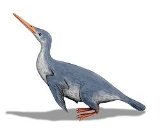
Waimanu
Encyclopedia
Waimanu is a genus
of early penguin
which lived soon after the Cretaceous-Paleogene extinction event. Its discovery helped support the idea that the radiation of the Neoaves (including most modern birds) either took place before the extinction of the dinosaurs, or that it must have been extremely rapid in geological terms. DNA-studies, e.g., the extensive one by Hackett and colleagues, seem to indicate the latter. While it was a very early member of the sphenisciformes (the order that included modern Penguins), Waimanu was flightless like all modern penguins. Though its wing bones do not show the extreme specializations modern penguins have for an aquatic lifestyle, it does seem adapted for wing-propelled diving, and may have resembled a flightless loon
in body shape and maybe the Great Auk
in its manner of locomotion. DNA sequence analyses and anatomy argue for a close relationships of penguins and loons, the former lineage specializing for wing-propelled and the latter for foot-propelled diving.
Discovered in Antarctica, in 1980, the name Waimanu comes from Māori
for "waterbird". Two species are known, Waimanu manneringi from the Middle Paleocene about 60 million years ago (mya) and Waimanu tuatahi from the Late Paleocene, perhaps 58 mya.
Genus
In biology, a genus is a low-level taxonomic rank used in the biological classification of living and fossil organisms, which is an example of definition by genus and differentia...
of early penguin
Penguin
Penguins are a group of aquatic, flightless birds living almost exclusively in the southern hemisphere, especially in Antarctica. Highly adapted for life in the water, penguins have countershaded dark and white plumage, and their wings have become flippers...
which lived soon after the Cretaceous-Paleogene extinction event. Its discovery helped support the idea that the radiation of the Neoaves (including most modern birds) either took place before the extinction of the dinosaurs, or that it must have been extremely rapid in geological terms. DNA-studies, e.g., the extensive one by Hackett and colleagues, seem to indicate the latter. While it was a very early member of the sphenisciformes (the order that included modern Penguins), Waimanu was flightless like all modern penguins. Though its wing bones do not show the extreme specializations modern penguins have for an aquatic lifestyle, it does seem adapted for wing-propelled diving, and may have resembled a flightless loon
Loon
The loons or divers are a group of aquatic birds found in many parts of North America and northern Eurasia...
in body shape and maybe the Great Auk
Great Auk
The Great Auk, Pinguinus impennis, formerly of the genus Alca, was a large, flightless alcid that became extinct in the mid-19th century. It was the only modern species in the genus Pinguinus, a group of birds that formerly included one other species of flightless giant auk from the Atlantic Ocean...
in its manner of locomotion. DNA sequence analyses and anatomy argue for a close relationships of penguins and loons, the former lineage specializing for wing-propelled and the latter for foot-propelled diving.
Discovered in Antarctica, in 1980, the name Waimanu comes from Māori
Maori language
Māori or te reo Māori , commonly te reo , is the language of the indigenous population of New Zealand, the Māori. It has the status of an official language in New Zealand...
for "waterbird". Two species are known, Waimanu manneringi from the Middle Paleocene about 60 million years ago (mya) and Waimanu tuatahi from the Late Paleocene, perhaps 58 mya.

